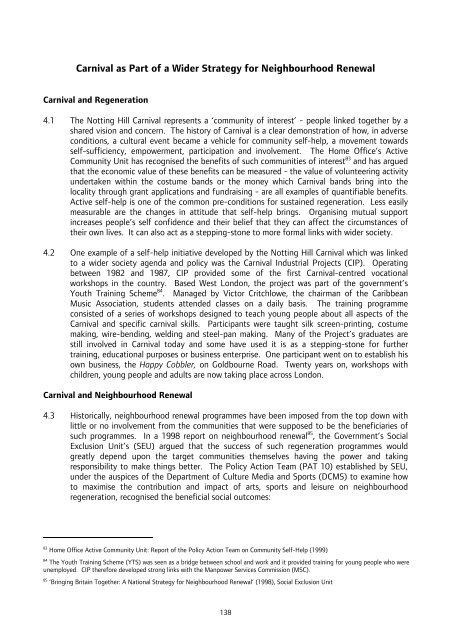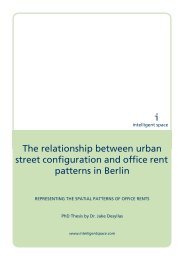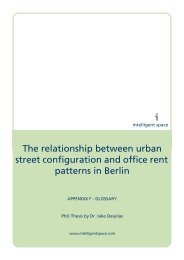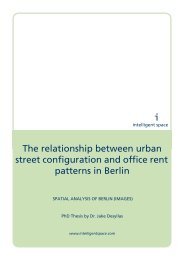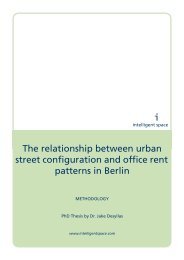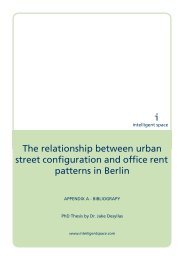Notting Hill Carnival Strategic Review - Intelligent Space
Notting Hill Carnival Strategic Review - Intelligent Space
Notting Hill Carnival Strategic Review - Intelligent Space
You also want an ePaper? Increase the reach of your titles
YUMPU automatically turns print PDFs into web optimized ePapers that Google loves.
<strong>Carnival</strong> as Part of a Wider Strategy for Neighbourhood Renewal<br />
<strong>Carnival</strong> and Regeneration<br />
4.1 The <strong>Notting</strong> <strong>Hill</strong> <strong>Carnival</strong> represents a ‘community of interest’ - people linked together by a<br />
shared vision and concern. The history of <strong>Carnival</strong> is a clear demonstration of how, in adverse<br />
conditions, a cultural event became a vehicle for community self-help, a movement towards<br />
self-sufficiency, empowerment, participation and involvement. The Home Office’s Active<br />
Community Unit has recognised the benefits of such communities of interest 83 and has argued<br />
that the economic value of these benefits can be measured - the value of volunteering activity<br />
undertaken within the costume bands or the money which <strong>Carnival</strong> bands bring into the<br />
locality through grant applications and fundraising - are all examples of quantifiable benefits.<br />
Active self-help is one of the common pre-conditions for sustained regeneration. Less easily<br />
measurable are the changes in attitude that self-help brings. Organising mutual support<br />
increases people’s self confidence and their belief that they can affect the circumstances of<br />
their own lives. It can also act as a stepping-stone to more formal links with wider society.<br />
4.2 One example of a self-help initiative developed by the <strong>Notting</strong> <strong>Hill</strong> <strong>Carnival</strong> which was linked<br />
to a wider society agenda and policy was the <strong>Carnival</strong> Industrial Projects (CIP). Operating<br />
between 1982 and 1987, CIP provided some of the first <strong>Carnival</strong>-centred vocational<br />
workshops in the country. Based West London, the project was part of the government’s<br />
Youth Training Scheme 84 . Managed by Victor Critchlowe, the chairman of the Caribbean<br />
Music Association, students attended classes on a daily basis. The training programme<br />
consisted of a series of workshops designed to teach young people about all aspects of the<br />
<strong>Carnival</strong> and specific carnival skills. Participants were taught silk screen-printing, costume<br />
making, wire-bending, welding and steel-pan making. Many of the Project’s graduates are<br />
still involved in <strong>Carnival</strong> today and some have used it is as a stepping-stone for further<br />
training, educational purposes or business enterprise. One participant went on to establish his<br />
own business, the Happy Cobbler, on Goldbourne Road. Twenty years on, workshops with<br />
children, young people and adults are now taking place across London.<br />
<strong>Carnival</strong> and Neighbourhood Renewal<br />
4.3 Historically, neighbourhood renewal programmes have been imposed from the top down with<br />
little or no involvement from the communities that were supposed to be the beneficiaries of<br />
such programmes. In a 1998 report on neighbourhood renewal 85 , the Government’s Social<br />
Exclusion Unit’s (SEU) argued that the success of such regeneration programmes would<br />
greatly depend upon the target communities themselves having the power and taking<br />
responsibility to make things better. The Policy Action Team (PAT 10) established by SEU,<br />
under the auspices of the Department of Culture Media and Sports (DCMS) to examine how<br />
to maximise the contribution and impact of arts, sports and leisure on neighbourhood<br />
regeneration, recognised the beneficial social outcomes:<br />
83<br />
Home Office Active Community Unit: Report of the Policy Action Team on Community Self-Help (1999)<br />
84<br />
The Youth Training Scheme (YTS) was seen as a bridge between school and work and it provided training for young people who were<br />
unemployed. CIP therefore developed strong links with the Manpower Services Commission (MSC).<br />
85<br />
‘Bringing Britain Together: A National Strategy for Neighbourhood Renewal’ (1998), Social Exclusion Unit<br />
138


